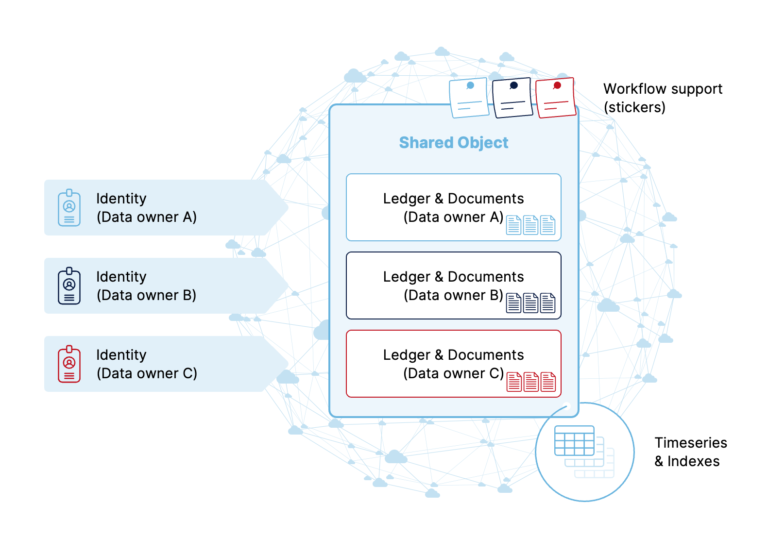Features
Enable data collaboration by using dynamic and flexible shared objects.
We designed our data collaboration platform based on shared objects inspired by the Digital Twin concept. A Digital Twin is a virtual representation of a real or an abstract object (e.g., an item, a device, a system, a process, an organization, a service, or a person) relevant for your business process. It is created dynamically by all partners and organizations involved in the business process and the main object of the platform – the Twin – ties together data from different Users and Accounts through Identities, Ledgers, and Docs attached by different Users.
The Trusted Twin platform acts as an exchange layer in the technology stack, so that data storing and sharing is decentralized, flexible, and secure. Learn more about the Digital Twin concept.

Create and manage shared objects
Basic operations
Basic operations include all operations on core objects that create a shared object (Twins, Identities, and Ledgers), together with functionalities to manage visibility and accessibility of data shared via shared objects.
This module provides you with all you need to develop standard data collaboration applications where multiple partners are involved in a business process.
Example operations: create_twin, get_twin_identity, update_twin_ledger_entry.
Batch operations
Batch operations allow you to perform bulk operations on shared objects (Twins, Identities, and Ledgers).
This module allows you to model, generate, and process large numbers of shared objects at once (e.g., registering production batches) as well as to read data for statistical purposes.
Example operations: coming soon.
Doc operations
Doc operations include all operations related to storing and sharing of Docs – status files of any type and size (e.g., images, videos, PDF files).
This module helps whenever files (e.g., reports, certificates, videos) need to be reliably stored and shared via shared objects.
Example operations: create_upload_url, attach_twin_doc.

History service
The History service lets you store the history of value changes of shared object Ledger Entries. The history of Ledger Entries can be used as well in more sophisticated services offered on the Trusted Twin platform (e.g., Timeseries service).
This service is the perfect choice when the history of Entries matters for your business (e.g, previous measurements, maintenance logs).
Example operation: get_twin_ledger_entry_history
Notifications service
The Notifications service allows to automatically invoke notifications (e.g., external services) each time a Ledger Entry of a shared object is changed. It offers multiple subscribe/notification technologies.
This service provides the ability to actively invoke notifications or initiate external actions triggered by events related to shared objects (e.g., leak detection in metering or alerts in predictive maintenance).
Example operations: webhook_subscribe, webhook_refresh_subscription
Timeseries service
The Timeseries service allows you to define and store shared object based time series data in the form of structured, multidimensional views. The data is stored in a relational database which allows for sophisticated SQL queries, historical and statistical analyses.
This service is often used for AI/ML related analysis as well as in predictive maintenance systems or monitoring solutions.
Example operations: update_timeseries_access, create_timeseries_table, get_timeseries_tables.
Indexes service
This service allows you to store structured, multidimensional views of shared object states. The data is stored in a relational database which allows for sophisticated SQL queries, historical and statistical analyses.
This service lets you access Ledger records efficiently among thousands of Twins and perform batch operations based on the selection.
Example operations: update_indexes_access, create_indexes_table, get_indexes_table
Logging service
This service provides you with the ability to monitor and debug operations on the Trusted Twin platform. It helps debug events in the system when you are developing more sophisticated applications.
This service is an essential tool to speed up development and increase the quality of applications.
Example operation: get_log
Integration service
The integration services provide you with the freedom to choose your preferred integration strategy and technology and collaborate effectively across multiple organizations with our technology-agnostic platform. For ease of use, the bare API is wrapped by libraries for the most popular programming languages.
The integration services allow you to interact with shared objects via MQTT to integrate your devices and at the same time via REST to use data directly from web applications.
Example operations: MQTT coming soon
Verifiability & Trust service
This service allows you to use blockchain to introduce verifiability and trust to your applications. Immutability of documents and irrefutability of events will be guaranteed by storing security information directly on the blockchain.
This service is a useful tool when an independent source of trust is what you need. It is a virtual version of a notary public service (e.g., to notarize documents attached to shared objects).
Example operations: Coming soon